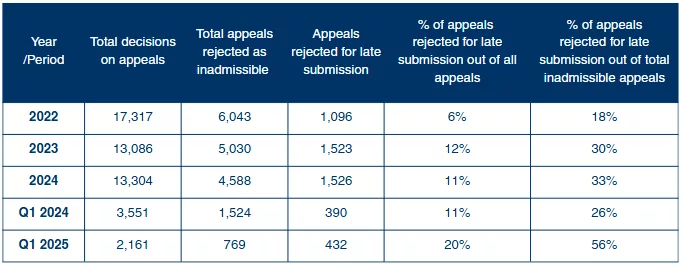
Read the article in Greek here.
Download the article in English in PDF here.
Co-authors: Sofi Sazo, Athina Kalogridi, Juliette Malfaisan
In a significant ruling, the Thessaloniki Administrative Court has reaffirmed that notifications of decisions on applications for international protection must be made in person to applicants residing in Greek reception facilities. This decision clarifies a salient procedural point: while Greek asylum law allows electronic notification ‘by default’, it explicitly mandates in-person delivery for asylum seekers in reception facilities. The decision is a welcome clarification, as the widespread practice of notifying decisions by email has raised concerns about its compliance with legal safeguards and its impact on asylum seekers’ access to legal remedies.
Legal framework on notification procedures
The possibility of notifying applicants for international protection via email was first introduced into the Greek legal framework in 2020(1), but only as a generic, ‘per default’ method. When it comes to decisions on asylum applications, and given the importance of such notification, special procedures are in place. Previously, decisions were delivered in person, at the time of renewal of the applicant’s asylum seeker’s card. Since 2019, if applicants reside in reception facilities, Greek law mandates that decisions be delivered to the facility’s managing director, with a notice posted for collection. Applicants are then required to visit the facility during its opening hours to collect the relevant documents, after which a report is completed, recording the delivery(2). These provisions ensure that applicants are informed in a manner appropriate to their circumstances.
In recent years, the Greek Asylum Service has increasingly favoured email notifications, citing efficiency and practicality, regardless of whether applicants are in a reception facility or not. This shift has been particularly pronounced since the COVID-19 pandemic and the suspension of interpretation services in 2024. The Asylum Service’s practice of emailing decisions to applicants in reception facilities disregards the above-mentioned legal requirements. This approach also fails to account for the specific needs of asylum seekers, further marginalising these already vulnerable populations.
In the event of a negative decision, applicants must act promptly within the limited timeframes provided by law in order to effectively exercise their right to a meaningful and timely appeal. However, this fundamental right is directly undermined when decisions are sent by email without adequate safeguards to ensure that applicants are properly informed, thereby hindering access to legal remedies.
Court rulings on unlawful electronic notifications
In a recent ruling(3), the Thessaloniki Administrative Court highlighted the unlawfulness of email notifications in reception facilities. Equal Legal Aid represented an applicant for international protection, who had been residing in the Alexandria reception facility. On August 30, 2023, the Thessaloniki Regional Asylum Office sent the first instance decision rejecting his asylum request via email. This email included a translated document informing the applicant of the right to file an administrative appeal within thirty days of receiving or becoming aware of the decision. The applicant submitted his appeal on October 17, 2023, explaining that although the decision was sent to the declared email address, it ended up in the spam folder, and was first discovered on September 27, 2023, when the lawyer requested and received a copy of the file. However, the Appeals Committee dismissed the appeal as out of time, arguing that the claim that the email was archived in the spam folder was unfounded and that there was no obvious force majeure in the applicant’s case. An annulment request was then filed before the Thessaloniki Administrative Court by ELA.
The court annulled the Appeals Committee’s decision, emphasising that the specific procedure of Article 87(4) – which provides for personal notification in reception facilities – must be followed, as it prevails over the general provision of Article 87(3), which allows for electronic notification by email.
Similarly, and prior to this decision, the Appeals Authority had found that email notifications to applicants residing in reception facilities were unlawful in two cases involving applicants from Sierra Leone, represented by ELA. In both cases, the applicants had been notified by email and had lodged late appeals. The Appeals Committee ruled that the appeals had been lodged in time as the applicants had not been properly notified. In particular, in one case(4), it was found that:
“[…] Since the appellant is still residing in the said Facility, the contested decision should have been delivered […] by sending it to the Head of the Facility and posting a notice so that the appellant could collect it, with a relevant service report drawn up. Therefore, given the above, the Committee finds that the decision was not lawfully delivered and the current appeal is considered to have been filed in time and is generally admissible.”
In the second case(5), the Appeals Committee ruled that:
“[…] The present appeal is presumed to have been filed within the deadline, given that there is no conclusive evidence in the file to confirm lawful notification of the contested decision to the appellant.”
This clearly confirms the primacy of personal notification in reception facilities over notification by email. However, the implications of these decisions go far beyond mere procedural considerations.
How digitalisation is reshaping asylum procedures and infringing human rights
In recent years, asylum systems in Europe have undergone a quiet but profound transformation, shifting from face-to-face communication with authorities to a digital-first model(6). From the submission of asylum applications to the notification of decisions, the entire procedure is being digitalised, including the controversial practice of online asylum interviews. The shift towards digital asylum procedures has been accelerated by the COVID-19 pandemic, and in Greece, the suspension of interpretation services in 2024(7) has certainly played a role if not aggravated the situation.
While digitalisation harnesses great potential to facilitate interactions between administrations and the public, it is unfortunately not a stand-alone policy and can become a dangerous tool. These considerations are not limited to asylum procedures, but have been raised in every area of interaction between administrations and the public where digitalisation has taken place. Digitalisation can become dangerous when it is used as a unique, one-size-fits-all solution, but also when it is flawed by design. As a result, this digital shift raises serious concerns about accessibility, legal certainty and procedural fairness – especially for vulnerable people with limited digital literacy or access.
In the Greek context, online platforms have been introduced in asylum procedures since the 2020s. Intended to facilitate the procedure, they are often unusable, at times making it impossible to submit asylum applications. Through a combination of administrative inefficiency and technical barriers, access to asylum seems to be deliberately restricted. The digitalisation of asylum procedures also neglects the specific circumstances of this population, including their living conditions and the systemic deficiencies of the reception system, and thus exacerbates their already precarious situation in more ways than one.
Special needs and vulnerabilities requiring concrete procedural safeguards
Asylum seekers face severe hardship before, during and after their exile. The vast majority experiences persecution, physical and psychological violence and abuse. Many are victims of trafficking for sexual or labour exploitation during their journey or upon arrival, not to mention detention, return or illegal refoulement. Upon arrival in Greece, their rights are repeatedly violated, and they endure substandard living conditions. Excessive bureaucratic procedures create insecurity, uncertainty, disappointment and fear of deportation.
Many asylum seekers do not have access to computers, as such services are not available in reception facilities. They also do not all have mobile phones with independent internet access; internet connectivity in facilities is often unreliable. In addition, their phones are frequently broken, destroyed or removed(8), while they may not be financially able to replace or repair them. Illiteracy or lack of digital literacy is quite common among the refugee population, especially among older adults. To make matters worse, emails from the Asylum Service often end up in spam folders, meaning that applicants do not receive any notifications, and the messages are automatically deleted after a few days. Even when applicants overcome these technical hurdles, their lack of familiarity with legal language often prevents them from understanding the content of the decisions, leading to confusion and uncertainty about their rights and obligations, which constitutes a violation of the right to information.
Combined with the individual circumstances of each applicant, these factors may create or exacerbate a combination of vulnerabilities that triggers States’ obligation to provide specific procedural guarantees. Under EU law, Authorities must take any necessary measures to create the conditions for effective access to procedures and enhance applicants’ ability to benefit from their rights and comply with their obligations throughout the asylum procedure. Accordingly, Greek asylum law provides for specific procedural guarantees for applicants presenting vulnerabilities(9):
“The Reception Authorities assess, within a reasonable period after the submission of the application for international protection or at any stage of the procedure where relevant needs arise, whether the applicant is in need of special procedural guarantees, due to, among other factors, age, gender, sexual orientation, gender identity, mental disorders, or as a result of torture, rape, or other serious forms of psychological, physical, or sexual violence.”
The Asylum Service’s routine use of email to communicate decisions, without any assessment of applicants’ individual circumstances or vulnerabilities, constitutes a serious breach of the duty to provide special procedural guarantees. It also disregards the potentially grave impact of such decisions on applicants’ rights and well-being.
Similarly, the practice of delivering decisions via email also negatively impacts self-accommodated asylum seekers (i. e. asylum seekers who do not reside in reception facilities, by choice or circumstances). Although the law does not explicitly prescribe a method for notifying applicants who are self-accommodated, it is evident that email delivery is equally problematic in such cases. For individuals living in precarious conditions or homeless, relying on emails for notification risks excluding some of the most vulnerable from accessing their rights.
Impact on access to legal remedies
The unlawful practice of electronic notifications undermines asylum seekers’ right to an effective remedy. While specific statistics on the number of asylum decisions communicated via email are not readily available, several reports highlight concerns regarding the shift towards digital notifications(10).
Rejections of appeals on formal grounds, specifically late submission, have risen sharply in recent years, highlighting growing procedural barriers for asylum seekers. In 2022, 1,096 appeals were dismissed as out of time; this number rose to 1,523 in 2023 and 1,526 in 2024. Alarmingly, 432 such rejections occurred in just the first quarter of 2025—a 10% increase compared to the same period in 2024(11).
Viewed as a share of all inadmissible appeals, late submissions accounted for 18% in 2022, increasing to 30% in 2023, 33% in 2024, and reaching 56% in early 2025. This indicates that over half of procedural rejections are now based solely on timeliness.
A similar upward trend appears when measured against total appeal decisions: late submission rejections rose from 6% in 2022 to 12% in 2023, held steady at 11% in 2024, and surged to 20% in the first quarter of 2025. The data points to systemic procedural hurdles that risk undermining fair access to justice.

Although causality cannot be definitively established, the high volume of late submissions suggests significant issues with how and when decisions are communicated. One likely contributing factor is the increasing reliance on digital methods, such as email, for notifying decisions, which may not always ensure effective communication with applicants of international protection. These procedural challenges are further compounded by broader access issues. Asylum seekers often struggle to meet strict deadlines due to limited availability of legal aid services, especially in regions like northern Greece, where few organisations, such as Equal Legal Aid, offer free legal representation. Other compounding factors include the chronic shortage in interpretation services and instances where decisions were reportedly issued during a period of legal aid service disruption, such as the registry lawyers’ abstention of duties during the last quarter of 2024 and in January 2025. Together, these obstacles raise serious concerns about appellants’ ability to access timely and fair review of their claims.
Normalisation of digital communication under the EU Pact on Migration and Asylum
The EU Pact places strong emphasis on the use of digital tools to streamline asylum procedures and enhance coordination among Member States. Under the current Asylum Procedures Directive, references to electronic communication are minimal. Decisions are required to be provided “in writing,”12) but this term is not clearly defined and does not explicitly encompass digital formats such as email. The Directive primarily refers to written notification in the context of informing applicants how to appeal. In contrast, the new Asylum Procedure Regulation (APR), adopted under the Pact, reflects a more explicit and structured approach to digital communication. While maintaining the requirement that decisions be issued “in writing,” the Regulation allows for notification through legal representatives and increasingly incorporates the use of electronic means, including email, at various stages of the procedure. Article 9(3)(13) notably introduces a new obligation for applicants to accept communication through the contact details they have provided, explicitly including email addresses. This marks a departure from the Directive, which only required notification to a physical address.
Overall, the APR represents a clear shift toward the normalisation of digital communication in asylum procedures. It institutionalises the use of electronic tools more firmly than the Directive’s more cautious, textually limited approach. While this may improve efficiency, it also underscores the need for safeguards to ensure that digital notifications are accessible, reliable, and do not undermine applicants’ rights, especially for those with limited digital literacy or access. However, the alarmingly high number of appeals rejected due to late submission indicates that this practice falls short in improving efficiency and rather exacerbates the barriers to justice, leaving vulnerable applicants at risk of losing their rights through no fault of their own. As the Pact is implemented, Member States may need to reassess their notification practices to ensure they are both legally sound and respectful of individuals’ rights to information, legal remedies, and due process.
CONCLUSION
Given the legal, procedural, and practical considerations, in-person notifications are essential for ensuring that asylum seekers are adequately informed of decisions profoundly affecting their rights. This approach aligns with the legal framework and addresses the specific needs of applicants residing in reception facilities. The recent court ruling serves as a critical reminder of the importance of adhering to legal procedures to safeguard the rights of asylum seekers. It calls for a reassessment of current practices and the need for in-person notifications. Treating international protection decisions as routine administrative acts, and delivering them via email, undermines the right to appeal and access to legal remedies, putting applicants’ rights at serious risk.
The EU Pact on Migration and Asylum emphasises the use of digital tools to expedite asylum procedures and improve coordination among member states. This emphasis on digitalisation raises concerns about the potential for increased surveillance and the impact on the rights of asylum seekers, as highlighted by various civil society organisations. The implementation of the Pact may necessitate a reevaluation of notification practices to ensure they align with both legal requirements and the rights of individuals seeking protection.
[1] Law no. 4686/2020, amending Law no. 4636/2019.
[2] Currently: article 87(3) and (4) of Law no. 4939/2022, transposing the EU Asylum Procedures Directives into Greek law.
[3] Thessaloniki Administrative Court, decision no. 6/2025.
[4] Decision no. IP/623133/03-10-2024 of the 6th Appeals Committee.
[5] Decision no. IP/32254/17-01-2025 of the 10th Appeals Committee.
[6] For more information, see Aida report on digitalisation of asylum procedures (2023), article from Forum Réfugiés “Digitalisation: multiple challenges for the asylum system” (2022), report from ELA, “Digitalisation of the Greek asylum procedure” (2022).
[7] Open letter from 36 civil society organisations, “Put an end to the disruption of interpretation services”, November 2024.
[8] Phone removal is a practice currently observed in Greek reception facilities that has recently been evidenced by several NGOs and independent media outlets.
[9] Regional Asylum Office of Lesvos 237274/26-04-20Article 72 of law 4939/2022, transposing the Asylum Procedures Directive (2013/32/EU).
[10] See above, 6.
[11] https://migration.gov.gr/statistika/
[12] Article 11 of the Directive 2013/32/EU of the European Parliament and of the Council of June 2013 on common procedures for granting and withdrawing international protection (recast).
[13] Article 9(3) of the Regulation (EU) 2024/1348 of the European Parliament and the Council of 14 May 2024 establishing a common procedure for international protection in the Union, repealing Directive 2013/32/EU, which will apply from 12 June 2026.

